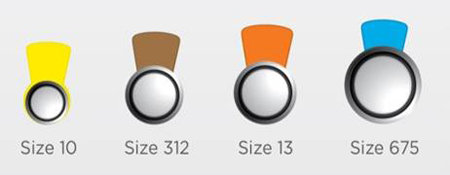The batteries are air-activated, which means they do not begin working until the coloured tab is removed and air is able to enter the battery cell. Remove and discard the tab only when you are ready to use the battery. There is no need to place the tab back on the battery.
Disposable zinc-air batteries come in four sizes and are colour coded to help you remember the right size.
- Size 10batteries have a yellow tab
- Size 13batteries have an orange tab
- Size 312batteries have a brown tab
- Size 675batteries have a blue tab

How long a hearing aid’s battery lasts depends on several factors, the first of which is the battery size. Small discreet hearing aids require a smaller battery with a shorter expected life. The smallest is size 10, which with typical use will last between 3-4 days.
On the other hand, a large loss of hearing will require a more powerful hearing aid, and therefore a larger battery is required, with size 13 batteries lasting 12-14 days and size 675 batteries used in superpower hearing aids lasting 3-4 weeks. The most common size, a 312 battery, lasts around 7-9 days.
It is important to keep in mind that hearing aids are miniaturized computers making thousands of calculations every second, and then amplifying the processed sound into the ear. The more advanced features that are activated, such as wireless connectivity, the faster the battery drain.
A very steady voltage is required and so Zinc-Air batteries are used, which are very different than most other batteries used around the home. Once the sticker is removed from the battery, air enters the cell and activates the current producing process. The battery will then produce voltage for a limited time, regardless of how many hours of use which is why occasional use to save battery life is often futile!
Environmental factors can also reduce battery life, such as very low or very high humidity, very cold conditions, and high altitude. We recommend you keep them in a cool dry place such as a desk drawer or bedside cabinet.


Since ears come in all shapes and sizes, it’s important to have a hearing healthcare professional customize an ear mould to fit the unique shape of your ear. These devices must be tight enough to prevent sound from leaking out and creating feedback—but not so tight that they cause pain.
The customization process is painless and includes making an impression of your ear canal and outer ear with a soft molding compound, much like a dentist would use to take an impression of your teeth.
There are mainly two types- soft and hard ear moulds and come in different styles. Your Audiologist would select the best suitable ear mould as per your hearing need.